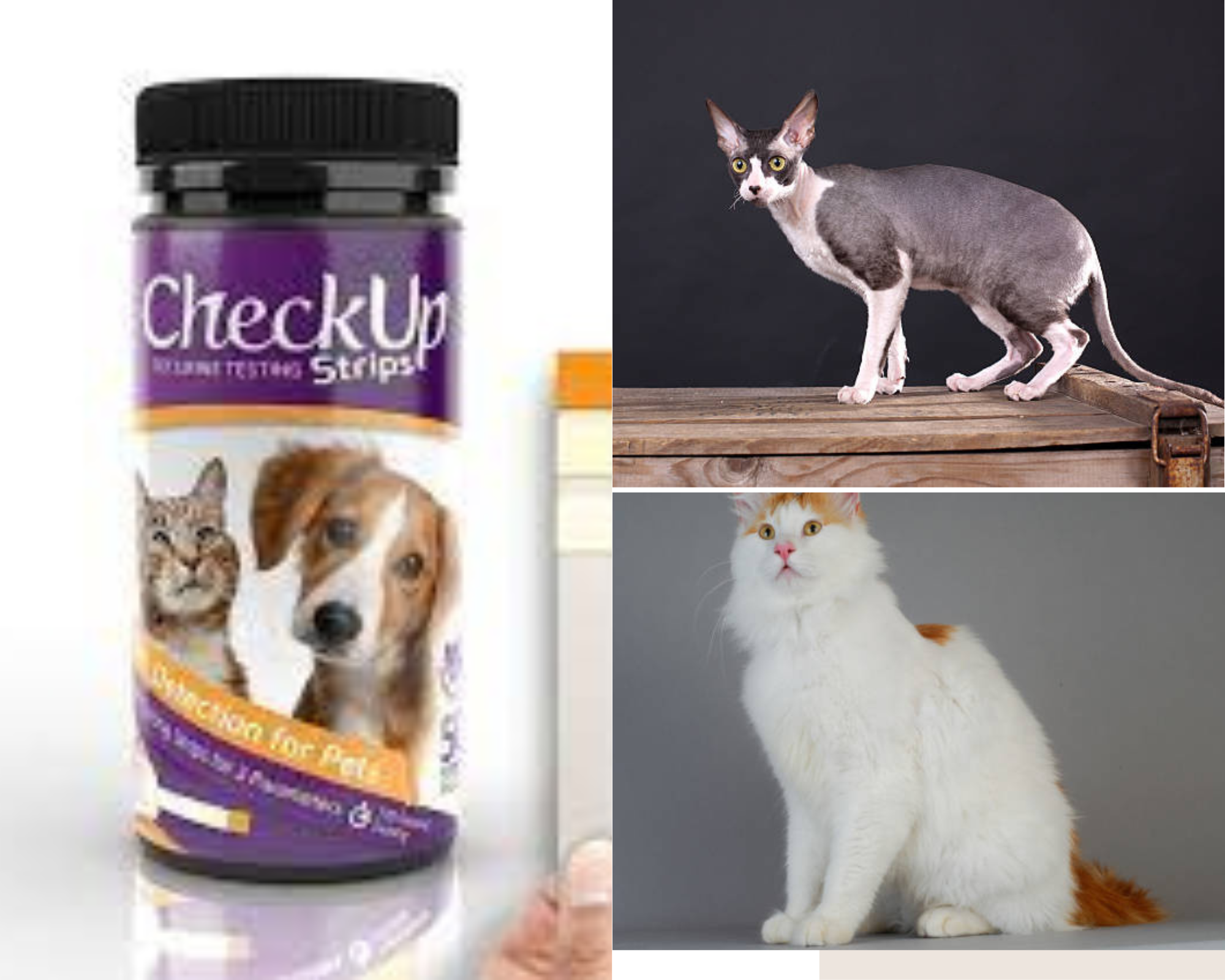Can I use human urine test strips on cats?

Urine test strips are extremely important for pets, and cats require them. If you are an old cat parent, you are probably aware of how important this can be to your pet’s health. It helps us understand what’s going on inside your feline friends by checking their pee for important signs, such as urinary tract infections or diabetes.
Over the years, test strips have played a significant role in medical diagnostics for both animals and humans. In the 1950s, advancements in medical technology led to the development of these diagnostic tools. Researchers and healthcare professionals realized the potential of using chemical indicators on strips to analyze urine for various health markers.
This innovation revolutionized the field of urinalysis, offering a quicker and more accessible way to detect abnormalities and monitor health conditions.
In this article, we discuss Urine Test Strips for cats and how to properly utilize them without having any issues and lastly, we let you know if you can use human urine test strips on cats.
Importance of Monitoring Cat Health
Every careless pet owner always faces a penalty for it, either their cats have health issues or they face Behavioral issues. Lack of proper care can lead to neglect-related problems such as malnutrition, untreated illnesses, and poor grooming.
And the best way many pet parents do this is by using urine test strips made for cats. These tests, often conducted with urine test strips, offer valuable insights into various aspects of your feline companion’s well-being.
Monitoring your cat’s health is essential to catch any potential issues early on. Regular observation of behavior, eating habits, and litter box patterns helps detect changes that could indicate health concerns.
Timely veterinary attention can make a significant difference in treating conditions like infections or dental problems. By staying vigilant and addressing health changes promptly.
How to Use Urine Test Strips for Cat
Using urine is supposed to be easy like abc but, due their litter box habits can make it difficult for every pet owner.
Here’s a step-by-step guide on how to collect a urine sample from a cat and use urine test strips:
Prepare a clean litter box or container:
Use a clean, non-absorbent litter box or container. You can also use plastic wrap or non-absorbent litter pellets to line the box/container.
Collect the urine sample
Place the clean litter box or container in the area where your cat usually urinates. Monitor your cat closely and wait for them to urinate. Once your cat has urinated, use a sterile syringe or pipette to collect the urine sample from the litter or container.
Dip the test strip
Remove a urine test strip from its container. Dip the test strip into the collected urine sample for a few seconds, ensuring all the pads are submerged.
Remove excess urine
After dipping, gently tap the strip against the edge of the urine container to remove any excess urine.
Wait for the results
Allow the urine test strip to develop according to the manufacturer’s instructions. This usually takes a minute or two. Observe the color changes on the pads and compare them to the color chart provided with the test strips to interpret the results.
Consult a veterinarian
Most of the time, after receiving the results, you may be confused and unsure what to do; all you have to do is contact your veterinarian. They will provide information about your cat’s health based on the urine test results.
Interpreting Test Results
Interpreting the results is where so many people feel frustrated and give up because they don’t know how to determine the illnesses their pets may have diagnosed.
But the truth is with a clear understanding of how to read urine test strips and interpret the color changes, pet owners can gain valuable insights into their pet’s health and take appropriate action to address any potential issues.
How to interpret Results urine test stripes results for Cats
1. Follow the instructions:
Always refer to the instructions provided by the manufacturer of the urine test strips for specific guidance on interpretation.
2. Observe color changes:
After dipping the urine test strip into the urine sample and allowing it to develop, observe the color changes on each test pad.
3. Compare with the color chart:
Hold the urine test strip next to the color chart provided with the test strips. Match the color of each test pad to the corresponding color on the chart.
4. Note the concentration or presence:
The intensity of the color change on each test pad corresponds to the concentration or presence of specific substances in the urine. Some common parameters tested include pH, glucose, protein, ketones, blood, leukocytes, nitrites, bilirubin, and urobilinogen.
5. Interpret the results: Based on the color changes and the reference color chart, interpret the results for each parameter tested. Results may indicate normal levels or abnormalities, which could suggest underlying health conditions.
Can I use human urine test strips on cats?
This is a question we receive every day on our Facebook page; using a human strip for your pet is not a bad idea, especially if you are short on cash. However, while human urine test strips can theoretically be used on cats, they are not recommended. Human and canine urines can differ in composition, and human urine test strips may not be designed to accurately assess the specific parameters relevant to a dog’s health.
Also, the result might not be reliable or accurate, potentially leading to misinterpretation of your dog’s health status.
Benefits and Limitations of Urine Test Strip
Using urine test strips for your cats offers a plethora of benefits, but it also comes with limitations. Nevertheless, the advantages outweigh the drawbacks.
These cat strips enable the early detection of health issues like urinary tract infections, kidney disease, and diabetes, facilitating prompt treatment and better management.
They provide convenience as they can be used at home or the veterinarian’s office, delivering quick results without the need for specialized equipment.
Additionally, urine test strips are cost-effective for monitoring chronic conditions such as diabetes or kidney disease, allowing pet owners to assess treatment effectiveness and make necessary adjustments.
Moreover, collecting urine samples for testing with strips is non-invasive and less stressful for cats compared to other diagnostic procedures.
Limitations
However, interpreting the results can be challenging and may require experience, and the information provided by urine test strips may be limited, necessitating additional diagnostic tests for a comprehensive assessment of a cat’s health.
Furthermore, collecting urine samples from cats can be difficult, especially for inexperienced pet owners, and may require patience and practice. Despite these challenges, the benefits of using urine test strips for cats generally outweigh the drawbacks, as they provide valuable insights into your pet’s health and well-being.
Best Urine Strips for Cats OR Dogs
| Product | Description | Rating | Price |
|---|---|---|---|
| life2O 10-Parameter Cat & Dog Urine Test Strips 60ct | Includes tests for glucose, specific gravity, pH, ketone, protein, and more | 952 | $9.89 ($0.16/Count) |
| Pet Test Strips for Dogs, Cats, and Other Animal Pets | Accurate urine monitoring and testing kit for various parameters | 248 | $16.97 ($0.17/Count) |
| One-Step Pet Urine Testing Strips, 100 x Urinalysis Parameter Tests | Accurate testing for veterinarians to detect UTI, diabetes, and more | 131 | $14.99 ($0.15/Count) |
| UTI Test Strips for Dogs, Cats, & Pets – 3 in 1-50 Count | Tests for urinary tract issues | 33 | N/A |
| KIT4CAT 2lb Hydrophobic Cat Litter for Urine Collection | Hydrophobic sand urine collection litter kit for cat urine sample collection | 2,973 | $14.95 ($14.95/Count) |
| CheckUp Kit at Home Wellness Test for Dogs | Detects 4 most common pet health indicators in urine | 578 | $19.95 ($19.95/Count) |
| CheckUp Glucose Urine Testing Strips for Cats and Dogs | Detection of glucose levels | 605 | $14.95 ($0.30/Count) |
CHECK OUT OUR FREE TOOLS: SULLPET GENERATOR TOOLS





